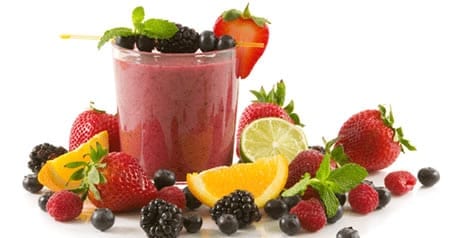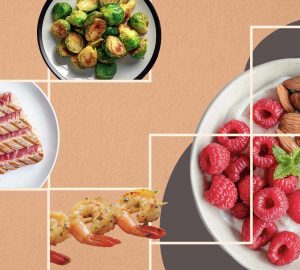By Randi Hawley
Many of us enjoy starting our days with a homemade blended beverage of some variety. Whether you call it a shake or a smoothie, most of us likely include some or all of today’s common ingredients: milk or milk substitute, fruit, protein or greens powder, and green leafy vegetables. Does this provide you with the best quality of nutrition and fuel to start your day? Is your beverage made of high-quality, clean, unprocessed, real food that won’t hurt you? Let’s look at each component, plus a few more to consider adding to your regimen.
Milk or milk substitute: It’s likely that you choose to use commercial dairy (usually low-fat), soy milk, almond milk, or coconut milk as a base for your beverage. Dairy and soy are controversial subjects these days and we’ll leave that debate for another day. Regardless of which liquid you prefer, it is best to choose the lowest-sugar variety. This may mean avoiding the lowest-fat variety because as fat is taken out of a processed food, it is often sugar that is added to compensate. In addition, if we want to load up with the vitamins and minerals from all of the things you’ll add to your drink, then the fat contained in the milk or milk substitute will aid in absorption of these nutrients by your body. About 1 cup of liquid is all you need.
Fruit: Sugar is sugar is sugar, and this, like dairy and soy, can also spark lively discussions. Usually the discussions revolve around which type of sugar is okay, or better for us, or less bad. In general, it’s best to choose a low-sugar fruit, or one that rates low to moderate on the Glycemic Index (a gauge of how quickly your body converts a fruit, vegetable, or grain into blood sugar). Berries are the best choice because they have low sugar, high fibre, and offer us a host of important nutrients and antioxidants. Other good choices are kiwi, melons, oranges, apples, peaches, and apricots. The total quantity of fruit should be about 1/3 cup to 1/2 cup.
Protein/Greens Powder: We’ve all heard that we should be including a protein powder or greens powder to our nutritional profile. Many athletes are quite attached to their protein powder, and it makes perfect sense that we are passionate about what we believe is good for us. Are these powders the best for optimal nutrition in our beverages? Have a look at the ingredient label of your powder. Does it have any wheat or gluten, dairy (including whey), eggs, soy (other than soy lecithin, which is not as harmful because it has little to no soy protein which causes soy allergies), excess sugar (5 grams or less per serving is suggested), peanuts, or corn or its many derivatives? These items all lead to inflammation in the body, and inflammation leads to disease. If you see any of these items in the list of ingredients, and in the interests of keeping your beverage as clean as possible, consider switching to a powder that doesn’t contain them. There are protein powders available (but more difficult to find) that are made with a base of pea, rice, and/or hemp that are unlikely to contribute to inflammation in the body, but remember to check the whole ingredient list to determine its suitability. Follow the same guideline for checking the ingredient list of your greens powder if you use one. Follow the suggested serving on the container or use less than directed.
Green Leafy Vegetables: Kale, spinach, swiss chard, beet greens, arugula, lettuce, herbs, etc. We have probably all heard that green leafy vegetables are extremely beneficial to our health. They’re brimming with fibre, vitamins, minerals, and plant-based substances that may help protect you from heart disease, diabetes, and perhaps even cancer. Let’s face it, not all of us enjoy the bitterness of some of the greens, or the work involved in chewing them enough to be able to swallow them, and we certainly don’t feel like doing it every day! Adding some to your blended beverage is a great way to incorporate them into your diet on a daily basis. Use about 30-50 grams, which is 1 large leaf or 2 smaller leaves of kale or 3 big handfuls of baby spinach.
Other Beneficial Additions
Hemp Seeds/Hemp Hearts: Hemp seeds are a complete protein and many consider it a superfood because of its rich nutrient profile including essential fats. Most health organizations agree that the human body requires a 3:1 or 4:1 balance of omega-6 to omega-3 essential fatty acids. Hemp seed is the only seed where this ideal balance naturally occurs. Choose raw hulled hemp seeds, and add 3-4 tbsp to your blender.
Flax Seeds: Flax seeds have 3 primary benefits – fibre, omega-3 fatty acids, and lignans. Lignans alter the way the body metabolizes estrogen, reducing the risk of breast cancer in women and prostate cancer in men. Because flax has a ratio of omega-6 to omega-3 of 1:4, when 4:1 is ideal, some sources believe that daily uses of flax may lead to a dangerous imbalance of the two essential fatty acids, especially when combined with the typical Canadian diet which includes high levels of omega-6 fatty acids from processed foods. Grinding the flax seeds makes the nutrients more readily available to the body because the hulls are broken down. Buy whole flax seeds that you can grind easily at home in small batches in a simple coffee grinder, and add 1-2 tbsp to your blender.
Chia Seeds: Chia seeds originated in Aztec and Mayan culture, and got their name from the Mayan word for “strength”. They have several of the same benefits of flax seeds, but don’t need to be ground up to easily reap all the benefits. Chia seeds are especially high in fibre. They can soak up about 12 times their weight in water, resulting in a slippery gel-like consistency that aids movement of material along the digestive tract while curbing appetite because the gel is so filling. Chia seeds are high in omega-3 essential fat, with a ratio of 1:3 omega-6 to omega-3. Choose whole raw chia seeds, and add 1-2 tbsp to your blender, depending on how thick you like your shakes.
Liquid Chlorophyll, E3 Live, TriPow Greens: Ultra-concentrated superfood green supplements are becoming more and more popular. Only small doses are required in order to provide a large boost in your nutritional profile. Finding a whole food supplement that contains both chlorella and spirulina is most beneficial. Chlorella is a superfood because of its high protein, essential fatty acids, and abundance of vitamins, minerals, and enzymes. It has more chlorophyll and nucleic acids than any other known plant. Spirulina is a superfood for the same reasons as chlorella. It has 2300% more iron than spinach! Many studies are showing the algae’s anti-inflammatory, antioxidant, and anti-cancer properties. Follow individual product label serving guidelines.
Coconut Oil: Coconut oil is another superfood that offers a host of health and nutritional benefits in small doses. It is extremely high in medium-chain triglycerides (MCT’s), the fat that doctors recommend we get more of. Lauric acid is one of the MCT’s, comprising about 50% of coconut oil. Lauric acid is found in mother’s milk and supports healthy metabolism. It is now being studied for its anti-fungal, anti-viral, and antibacterial health-protecting properties. Choose organic cold-pressed virgin coconut oil, and add 1-2 tbsp to your blender.
Bee Pollen: Bee Pollen is foraged by bees from plants and flowers. It is very high in protein, vitamins, and minerals, while also offering amino acids, essential fatty acids, enzymes, and co-enzymes. Taking bee pollen can have a wide range of positive effects on a person’s health and wellness, not limited to increased resistance to seasonal pollen allergies, good brain health and function, uplifted mood, supported immune function, improved digestion, and hunger suppression. Because bee pollen is a natural allergen, you should not take it if you’re allergic to bee stings or bee products. For all other people with no known reactions to bees, it’s advised to test your use of bee pollen by putting one grain under your tongue and waiting 5-10 minutes to see if any reaction occurs. Because bee pollen can be very energizing, avoid taking it after 4pm. Gradually increase the serving in your beverage to 1 or 2 tbsp per day.
Loose Ends
-These blended beverages can be enjoyed any time of day, not just in the morning. Try them for supper, a mid-afternoon snack, or post-workout.
– If you have a good number of the above items in your drink, your body will enjoy a nutrient dense meal that is more bio-available and easily digested because of its liquid form.
– Depending on the ingredients you choose, you will hopefully feel satiated and satisfied for a while due to good levels of protein and fat.
– It is not necessary to include all of the above items into your drink every day. If you do, your beverage will be very thick. Vary your selection from day to day or week to week to give your body a wide-ranging buffet of nutrients.
– Not sure whether to buy organic fruits and vegetables or not? If you’d rather save some money where you can, follow this rule of thumb:
If you peel it to eat it, non-organic is okay. If you eat the skin or eat it whole (such as green leafy vegetables), then buy organic.
Alternatively, follow the Dirty Dozen and Clean Fifteen lists prepared by The Environmental Working Group every year.
– Decide if you really need that protein powder. Protein powder is highly processed. Do some research on how much protein your body can process at once, and what happens inside your body if you consume too much. For some, simply following the recipe below will provide plenty of whole food, clean, unprocessed or less-processed, non-inflammatory sources of protein.
– Filtered water can also be used as your liquid base, instead of milk or a milk substitute. The beverage won’t be as thick, and will likely have less total sugar.
– Remember that as you choose ingredients that have less sugar than you’re used to (water vs. sweetened almond milk, or berries vs. bananas), your drink will taste less sweet. Give your tastebuds some time to adjust and soon you’ll be rejoicing in how tasty real, low-sugar food can be.
– f finding local ingredients is of value to you, you can often find local bee pollen, Canadian flax seeds, and Canadian hemp seeds at Edmonton area farmer’s markets, along with local produce for your shakes. TriPow Greens (mentioned above) is an Edmonton-based product. There are Canadian producers of protein powders that use pea, rice, and/or hemp protein as their base, and these are available in retail locations across the city.
Morning Smoothie
1 cup So Delicious Coconut Milk, unsweetened
4 tbsp hemp seeds
1 tbsp chia seeds
1 tsp bee pollen
1 tbsp organic coconut oil
1 tsp TriPow Greens
1/3 cup frozen organic blueberries
1 large leaf of organic kale
Add all ingredients to a blender or VitaMix machine, blend, and enjoy.
Nutritional Information: 470 calories, 39gr fat, 27mg sodium, 454mg potassium, 20gr carbohydrates, 10gr fibre, 8gr sugar, 16gr protein
Vitamin and Mineral Profile based on RDI of a 2000 calorie diet: Vitamin A 60%, Vitamin C 67%, Calcium 14%, Iron 36%, Vitamin B6 5%, Vitamin E 75%, Thiamine 36%, Riboflavin 258%, Niacin 15%, Phosphorous 37%, Magnesium 72%, Zinc 29%, Copper 31%, Manganese 87%. Does not include vitamin and mineral profile of coconut milk, coconut oil, bee pollen, or TriPow Greens.
Author Profile:
Randi has a passion for health, wellness, fitness, and strong communities. She follows a path of continuous learning and self-improvement and gets great joy out of sharing her knowledge and enthusiasm with others.








